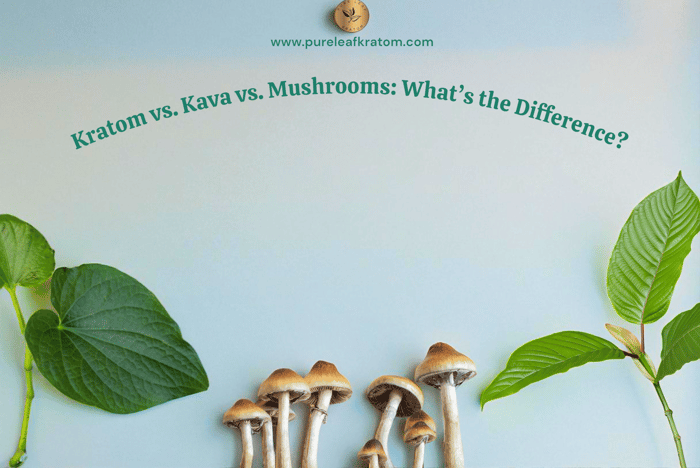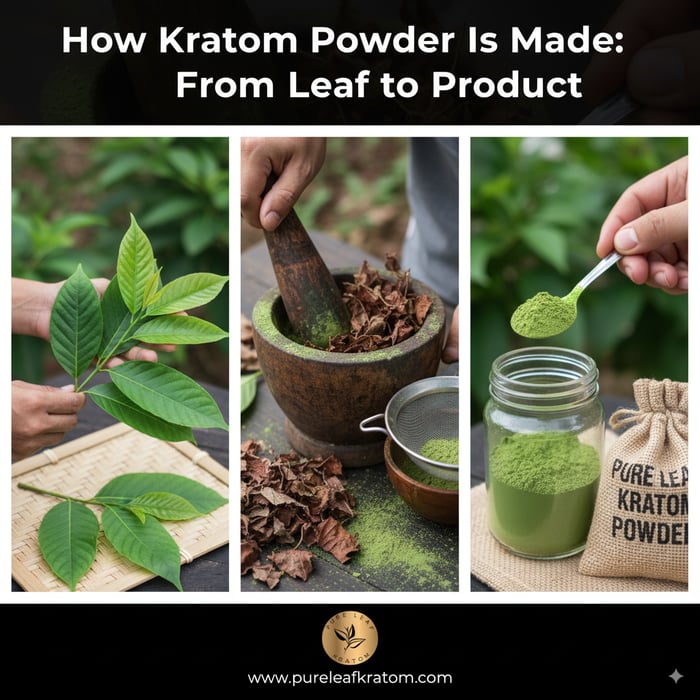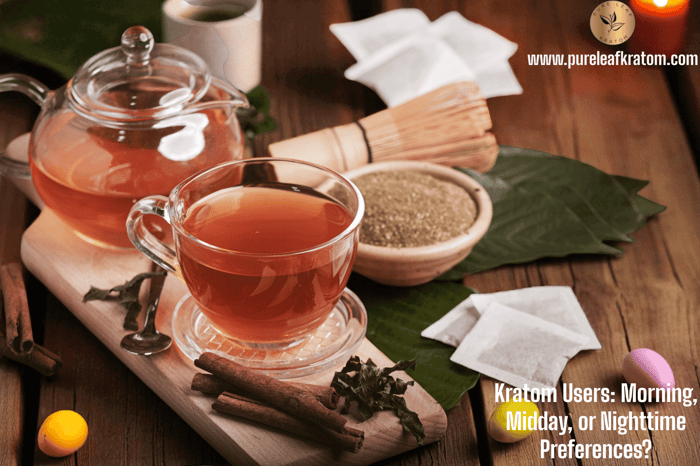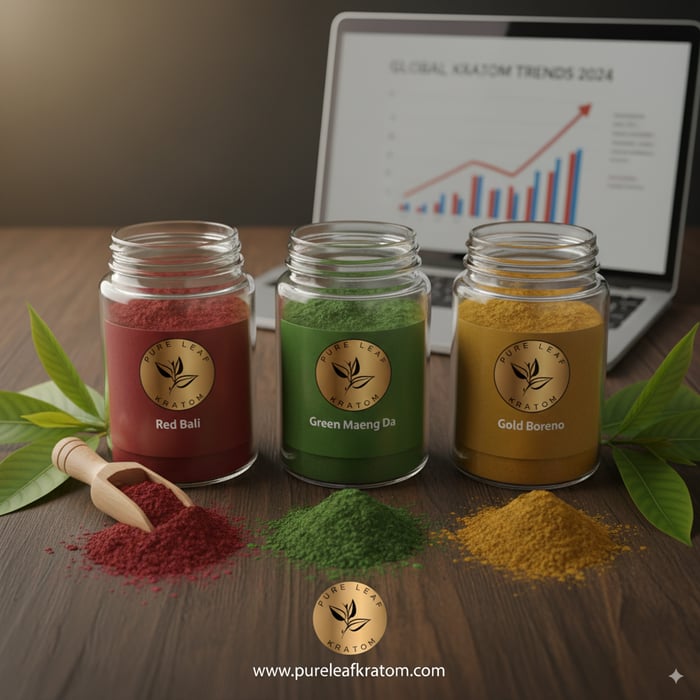
Kratom vs. Kava vs. Mushrooms: What’s the Difference?
Table of Contents
- Understanding the Basics: Origins and Botanical Lineage
- Processing and Formats: How They’re Consumed Today
- Taste and Texture: What to Expect from Each
- Cultural Significance and Traditional Use
- Modern-Day Appeal: Why People Are Reaching for Botanicals
- Legality and Sourcing Considerations
- Combining Botanicals: Should You Mix Them?
- Flavor Profiles Compared
- Conclusion: Three Botanicals, Endless Possibilities
- FAQs
Kratom vs. Kava vs. Mushrooms: What’s the Difference?
As the world of natural botanicals continues to grow in popularity, three standout plant-based products have captured the attention of enthusiasts around the globe: Kratom, Kava, and functional Mushrooms. Each offers a distinct experience rooted in centuries of cultural tradition, and today they’ve evolved into a wide range of modern formats powders, capsules, teas, gummies, and more designed to fit into a variety of lifestyles.
Though they’re often grouped together in the broader conversation about natural alternatives, Kratom, Kava, and Mushrooms are fundamentally different from the regions they come from and the parts of the plant (or fungi) that are used, to how they’re prepared and the experiences they’re said to inspire.
Whether you're exploring botanicals for the first time or looking to deepen your understanding, this guide offers a clear, professional look at what makes each of these three options unique. Without diving into medical claims or health-related terminology, we’ll explore their origins, cultural context, common formats, flavor profiles, and how people are using them today.
Ready to find your fit? Let’s break down the differences between Kratom, Kava, and Mushrooms and what makes each one a world of its own.
Understanding the Basics: Origins and Botanical Lineage
To truly appreciate the differences between Kratom, Kava, and Mushrooms, it’s essential to begin with the roots both literally and figuratively. While these botanicals are often discussed side by side, their origins tell three very different stories. Each comes from a distinct region of the world, shaped by its own climate, culture, and traditional use. From the dense rainforests of Southeast Asia to the sun-soaked islands of the South Pacific to the shaded forests where functional mushrooms thrive, these botanicals have developed independently, nurtured by the people who first discovered their unique properties.
What’s more, they don’t even belong to the same plant family or kingdom, in the case of mushrooms. Kratom is a tropical tree from the coffee family, Kava a root-based shrub from the pepper family, and Mushrooms aren’t plants at all but rather part of the fungi kingdom. These biological differences alone impact everything from how they grow and how they’re harvested to the way they’re prepared and consumed.
Understanding these foundational distinctions is the first step in recognizing why Kratom, Kava, and Mushrooms each offer something entirely unique not just in experience, but in identity.
Kratom (Mitragyna speciosa)
Region of Origin: Southeast Asia – Thailand, Indonesia, Malaysia
Plant Type: Evergreen tree
Plant Part Used: Leaf
Traditional Use: Chewed fresh or brewed as tea by native populations
Kratom is a member of the coffee family (Rubiaceae). While it doesn’t contain caffeine, the leaves have historically been valued by agricultural workers and rural communities who wanted to maintain stamina or wind down at the end of a long day.
Kava (Piper methysticum)
Region of Origin: South Pacific Islands – Fiji, Vanuatu, Tonga
Plant Type: Shrub
Plant Part Used: Root
Traditional Use: Ground and infused in water for ceremonial gatherings
Kava is part of the pepper family (Piperaceae), and it’s deeply ingrained in Pacific Island culture. For centuries, it has been consumed in communal settings during rituals, celebrations, and discussions.
Mushrooms (Functional Fungi)
- Region of Origin: Global – especially Asia and North America
- Plant Type: Fungi (not a plant, but a separate biological kingdom)
- Part Used: Fruiting body (the mushroom cap and stem)
- Traditional Use: Used in culinary and ritualistic contexts across multiple ancient cultures
The term “mushrooms” here refers not to culinary varieties, but to functional mushrooms such as Lion’s Mane, Chaga, Cordyceps, and Reishi. These fungi have historically been used in tea-like tonics and spiritual traditions but in today’s market, they’re more often found in modern formats like gummies and vapes. These formats offer a highly convenient and flavorful way to explore the benefits and taste of mushrooms without the need for brewing or blending.
Processing and Formats: How They’re Consumed Today
With modern innovation reshaping how we engage with traditional botanicals, Kratom, Kava, and functional Mushrooms have expanded far beyond their ceremonial or ancestral roots. Once consumed in raw, brewed, or foraged forms within local communities, these botanicals are now available in an impressive variety of convenient, lifestyle driven products designed for today’s consumer. Whether it’s a pre-measured capsule, dissolvable powder, flavorful gummy, portable liquid shot, or ready to drink blend, there’s a format to match nearly every preference and routine. This shift has made it easier than ever for people to integrate these botanicals into their daily lives, whether at home, in social settings, or on the go.
Equally important is the evolution in flavor and presentation. Traditional forms of Kratom, Kava, and Mushrooms often carried strong, earthy, or bitter tastes that could be difficult for newcomers to enjoy. Today’s offerings are frequently infused with fruits, herbs, spices, and natural sweeteners to create a more inviting experience without compromising the botanical integrity. From clean, minimalist formulations to complex herbal stacks, the modern product landscape reflects a balance between honoring tradition and embracing innovation making these time-tested botanicals more accessible, enjoyable, and versatile than ever before.
Kratom Product Formats
Finely ground powder (most traditional format)
Capsules for easy, flavorless consumption
Tablets for controlled serving sizes
Liquid shots, often flavored and fast-acting
Resin extracts or vape blends in select markets
Gummies and chews, often in fruity varieties
Kratom products are often labeled by strain type Green, Red, White, and sometimes Yellow each associated with different user-reported experiences.
Kava Product Formats
Powdered root for traditional brewing
Instant Kava drinks for quick prep
Pre-bottled Kava beverages in various flavors
Kava capsules and tinctures
Kava candy chews and gummies
Some kava lounges serve freshly brewed traditional kava in ceremonial bowls, while retail outlets focus on modern, easy-to-consume formats.
Mushroom Product Formats
Gummies in fruity or herbal flavors
Vape pens or cartridges featuring mushroom extract blends
Functional snacks like infused chocolates and bars
Liquid tinctures
Capsules and softgels (less common in this comparison)
Today’s mushroom gummies and vape blends are especially popular among those looking for an effortless addition to their routine. Gummies often combine multiple mushroom species for a stack effect, while mushroom vape formulas offer a fast, flavorful experience in a portable device. These convenient options are ideal for those who prefer quick, accessible ways to try functional fungi without any prep work or strong earthy flavors.
Taste and Texture: What to Expect from Each
Kratom
Kratom has a very distinct and recognizable flavor profile often described as deeply earthy with pronounced bitterness and grassy undertones. Many users compare it to an extra-strong green tea, but with a noticeably astringent edge that can linger on the palate. This strong taste is largely due to the natural alkaloids present in the Kratom leaf, which contribute to both its potency and its bold, unmistakable flavor. For individuals new to Kratom, the taste can be a bit of a surprise, especially in its pure powdered form where no flavors are masked or modified.
Because of this, Kratom is rarely consumed for its taste alone. While traditional users in Southeast Asia may chew fresh leaves or brew them into plain tea, modern consumers often prefer flavored versions to make the experience more enjoyable. Today, it's common to find Kratom shots enhanced with citrus, berry, vanilla, or tropical fruit essences, which help to cut through the bitterness. Others may blend Kratom powder into smoothies or mix it with honey and lemon to balance the flavor. As Kratom continues to grow in popularity, manufacturers have become increasingly creative with taste masking innovations making it more accessible to those who may be hesitant to try it due to its natural flavor intensity.
Best paired with: Citrus, berry, or mint
Texture: Powdered forms can be gritty; shots are smoother
Kava
The taste of Kava is often described as earthy, peppery, and somewhat bold, with a strong natural presence that reflects its root-based origin. It carries a flavor profile that is unmistakably rooted in the soil from which it comes deep, grounded, and slightly bitter, often accompanied by a subtle spiciness reminiscent of black pepper. One of the most unique characteristics of Kava is its numbing mouthfeel, which many users notice shortly after taking a sip. This sensation, particularly around the tongue and lips, is a natural result of kavalactones active compounds found in the root that contribute to the overall experience.
In terms of texture, traditional Kava preparations can feel thick or even slightly gritty, especially when made the customary way: by kneading the ground root in cold water and straining it through a cloth. This method results in a muddy, opaque liquid with a consistency that some find chalky or creamy. While this rustic texture is appreciated in ceremonial settings and authentic Kava bars, it can be a challenge for those not accustomed to it. As a result, modern Kava products often undergo additional filtration or are blended into flavored beverages, chews, or extracts to provide a smoother, more palatable experience. Today’s market also includes options infused with coconut, cacao, or vanilla flavors that soften Kava’s earthiness and make it more enjoyable for a wider audience. Still, many longtime users appreciate and even seek out that signature flavor and mouthfeel, viewing it as a mark of authenticity and tradition.
Best paired with: Coconut, cacao, vanilla, or tropical fruit
Texture: Smooth when brewed properly; can be thicker in traditional forms
Mushrooms
Functional mushrooms vary depending on the species and format, but gummies and vapes offer some of the most approachable ways to enjoy them. Mushroom gummies are typically infused with fruity or herbal flavors masking the woody or earthy undertones of raw mushrooms while still delivering a recognizable mushroom character. These gummies are soft, chewy, and easy to enjoy any time of day.
Mushroom vapes, on the other hand, often feature terpene-enhanced blends for a smooth, aromatic experience. While the exact taste varies by formula, many users describe mushroom vape flavors as earthy, herbal, and slightly sweet, especially when combined with botanical extracts like mint, berry, or vanilla. These vapes are sleek, portable, and designed for quick use without preparation or cleanup.
Best paired with: Fruity, mint, or vanilla flavors
Texture: Chewy for gummies; smooth and aromatic for vapes
Kratom
Described as offering a balanced, sometimes energizing or grounding effect
Different strains yield different user-reported sensations:
Green strains: Level-headed, centered
White strains: Clear and energized
Red strains: Slower, calming rhythms
Kava
Often described as deeply calming, mellow, and tranquil
Tends to encourage stillness, making it popular for quiet evenings or social moments
The effects are generally gentle and wave-like
Mushrooms
Frequently associated with clarity, creative focus, and daily grounding
Users often report enhanced experiences with journaling, meditating, or brainstorming
Popular among those who prefer a natural, clean supplement without intensity
Cultural Significance and Traditional Use
The cultural backdrop behind each of these botanicals adds depth to their identity.
Kratom
In Southeast Asia, Kratom has been part of rural life for centuries. Leaves were often chewed raw or brewed into tea to complement long days or to mark important life transitions. Farmers, elders, and community members passed down knowledge orally, creating a tight-knit relationship with the plant.
Kava
Kava has played a major role in Pacific Island traditions, where it is often consumed during village ceremonies, disputes, or celebrations. It is more than a beverage it’s part of a social fabric. Kava bowls are shared among guests as a symbol of peace, community, and connection.
Mushrooms
Fungi have been present in the mythology and rituals of ancient cultures ranging from China and Japan to Mesoamerica and Russia. Some varieties were considered sacred and only consumed by elders or spiritual leaders. Modern adaptations have focused on functional mushroom species known for daily consumption.
Modern-Day Appeal: Why People Are Reaching for Botanicals
Today, these botanicals appeal to a wide spectrum of consumers:
Kratom users often seek something that fits into morning routines or evening downtime
Kava enthusiasts prefer a social, unplugged experience without alcohol
Mushroom lovers look for an easy way to feel aligned and focused throughout the day
None of these options fit a one-size-fits-all model. That’s part of the appeal. The diversity in format, flavor, and sensation makes each option adaptable and personal.
Legality and Sourcing Considerations
It’s crucial to understand the legal and ethical sourcing of botanicals before diving in.
Kratom
Kratom legality varies widely by region, with certain states or cities placing restrictions. Responsible vendors often emphasize lab testing, transparent labeling, and ethical farming practices to ensure product safety.
Kava
Kava is legal in most Western countries, although it's often subject to import standards and quality testing. Premium kava is usually sourced from noble kava varieties grown in Fiji or Vanuatu.
Mushrooms
Functional mushrooms are legal and widely available in most regions. Many reputable companies source organic mushrooms from trusted growers in Asia or North America, and some prioritize fruiting body only extracts rather than mycelium blends.
Combining Botanicals: Should You Mix Them?
Some consumers enjoy layering botanicals or alternating them based on the time of day. Here’s how a sample rotation might look:
Morning: Functional mushrooms in coffee or tea
Afternoon: Green vein Kratom or a focus-enhancing blend
Evening: Kava beverage or soft chew before a slow evening
While combining botanicals can be appealing, it’s always wise to start with one, observe your experience, and build from there.
Flavor Profiles Compared
| Botanical | Flavor Notes | Common Enhancements |
|---|---|---|
| Kratom | Bitter, earthy, grassy | Lemon, mint, berries |
| Kava | Peppery, muddy, numbing | Cacao, coconut, vanilla |
| Mushrooms | Woody, mild, tea-like | Cinnamon, coffee, chocolate |
Here are some questions to help determine your preference:
Do you enjoy versatile products that can be energizing or mellow?
Try Kratom, especially in mixed-strain sample packs.Looking for a deeply grounding beverage to enjoy socially or during a quiet night in?
Start with Kava, especially a noble root powder or flavored drink.Need a clean, everyday companion to pair with your morning ritual?
Explore functional mushrooms like Lion’s Mane or Cordyceps.
Remember, it’s okay to explore all three. Many people rotate between them depending on their goals, preferences, and routines.
Conclusion: Three Botanicals, Endless Possibilities
Kratom, Kava, and Mushrooms may all live under the umbrella of natural botanicals, but they offer completely different experiences, rooted in centuries of cultural use and adapted for modern lifestyles. Whether you’re sipping a Kava latte, adding Lion’s Mane to your morning brew, or experimenting with flavored Kratom shots, each offers a new path for exploration.
In a world increasingly interested in natural alternatives, these three botanicals shine in their own way. The key is not to choose the “best” one but the best one for you.
FAQs
1. What is the main difference between Kratom, Kava, and Mushrooms?
Kratom is a leaf from a Southeast Asian tree, Kava is a root from a South Pacific shrub, and functional Mushrooms are fungi. Each comes from a different region and is prepared in distinct ways, offering unique traditions, flavors, and modern product formats.
2. Do they belong to the same plant family?
No. Kratom belongs to the coffee family, Kava to the pepper family, and Mushrooms aren’t plants at all they’re part of the fungi kingdom.
3. What parts are used for consumption?
Kratom: The leaves
Kava: The roots
Mushrooms: The fruiting body (cap and stem)
4. How are they traditionally consumed?
Kratom was chewed or brewed as tea in Southeast Asia, Kava was prepared as a ground root drink in communal ceremonies, and Mushrooms were used in tonics, rituals, and cultural practices across Asia, Mesoamerica, and beyond.
5. What modern formats are available today?
All three botanicals now come in powders, capsules, gummies, tinctures, and ready-to-drink blends. Kratom and Mushrooms can also be found in vape form, while Kava is widely offered in beverages and candies.
6. How do the flavors compare?
Kratom: Bitter, earthy, grassy — often enhanced with citrus or berry flavors
Kava: Peppery, earthy, numbing — often paired with coconut, cacao, or vanilla
Mushrooms: Woody, mild, tea-like — often blended with fruity or chocolate notes
7. Are Kratom, Kava, and Mushrooms legal everywhere?
Functional Mushrooms are legal in most regions. Kava is generally legal but may be subject to import restrictions. Kratom’s legality varies by state, country, or municipality, so it’s important to check local regulations before purchasing.
8. Can they be combined?
Some people rotate or layer botanicals depending on the time of day such as mushrooms in the morning, Kratom in the afternoon, and Kava in the evening. However, newcomers usually start with one to better understand how it fits into their lifestyle.
9. Which one is best for beginners?
It depends on personal preference. Beginners often find mushroom gummies approachable, Kava beverages socially inviting, and Kratom capsules convenient for avoiding its strong taste.
10. Do they all serve the same purpose?
No. Each offers a different cultural background, flavor profile, and consumer experience. Rather than competing, they complement each other as unique botanicals with distinct roles.




